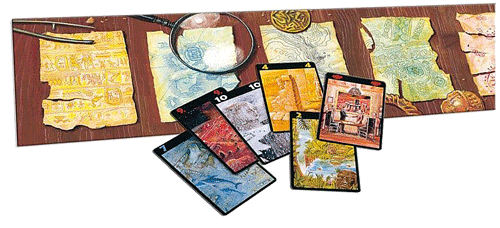
Lost Cities started out as an interesting two-player game (the focus of this page) and has grown to greatness as a four-player board game, using a very similar core concept, with additional elements to expand the choice and challenge.
Who’d have thought that a pack of cards (very nicely decorated) could take you to such exotic spots as the Himalayas, American rainforests, or Egyptian deserts – but there you go! Miracles do exist 😀
Players are explorers, seeking to make their way to the five exquisite, explorable places and (ever hopeful) their lost cities. They do this by way of putting down numbered cards that power their onward progress.
One of the interesting things about Lost Cities is that every expedition starts out with a negative score: minus 20 points. It’s as true as in the real world – before the expedition can commence, there are costs, and these must be met. If they’re not, the expedition may end up in the red – I told you not to go Bertie.
The expedition cards for the base game come in five colours, each representing a different one of the five ventures. There are nine cards in each of the five sets, numbered 2 to 10. Though it doesn’t happen during the course of the game, laying them side by side may reveal something almost magical.
When all the cards are shuffled together at the start, there also are three cards of each colour (15 cards in all) that show a pair of hands, shaking to confirm a deal. They’re betting on the outcome of the expedition: their gambling ways may affect things quite substantially.
The wager cards aren’t numbered – they can be played by a risk-taker before any of their expeditions, and for each one that’s laid down at the start, the expedition’s final outcome score gets multiplied. One risky handshake means that the score gets doubled: two handshakes, and it’s trebled: three and it’s four times the expedition’s final score.

Moving on – each turn, players must let go of one of their cards – either by adding it to the expeditionary area that’s nicely displayed on the small board, or by discarding it. If playing to the board, they can seek to move further forward along one of up to five expeditionary paths (the five colours, and their five destinations), or they might risk putting down a wager-card.
That can happen only at the very start, before any of the player’s explorers have taken steps along the path. So you can’t begin a bet when it’s clearly going to be an advantage: you have to risk all before you begin.
There goes another fingernail 😄
Once having put a card down or discarded, the player takes up a replacement either from the main stock, or from those previously discarded.
Whatever they decide, players always are aware that the opposing expedition leaders are sitting there, closely holding their cards to their chest – cards that might curtail our progress (as we would hope to curtail theirs). Take care when discarding, then. Expedition leaders try not to discard willy nilly, lest they leave the opposition something to their advantage.
Once all the cards have been used up, the outcomes of the expeditions are appraised, simply using the numbers showing on the card of the lead-explorer in each expedition, and tallying in the initial costs and the effects of any wagering that took place. The game’s best played over three expeditionary rounds, which may help to even out the luck factor that comes with the random flow of cards as they are drawn from the deck.
It may seem fairly simple, but comments from around the world suggest that there’s a lot more to the cities than comes with a first glimpse: it appeals to many (but not to all, of course). The two and more-player games are both well regarded by many, though not everyone likes Lost Cities.
Venturesome!
- can be learned quickly
- no setting up
- replayable – but don’t play too frequently or it might lose its novelty
- quite a lot of luck is involved
- plenty of chances to push your luck
- but some careful deliberation too

